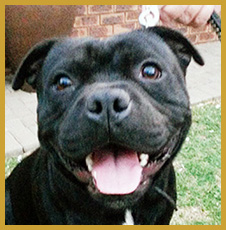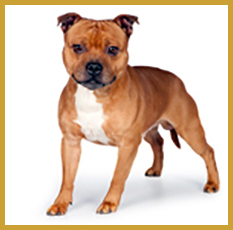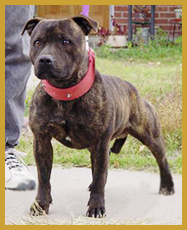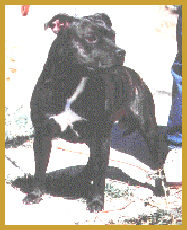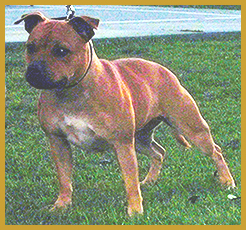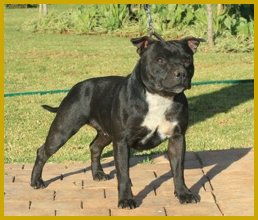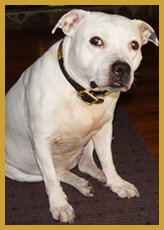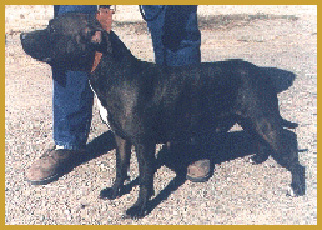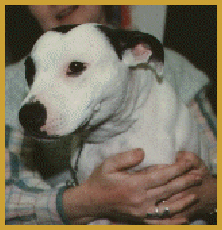Breeders Corner
The Breeders Forum - Article I
QUO VADIS, MRS. STAFFORD?
["Quo Vadis": Latin for "Where are you going?"]
After visiting 1997 Crufts, I posted a message to the Staffordshire Bull Terrier Mailing List, containing the following excerpt:

"... the bitches were much more even in size and type than they were in 1966. Gone were the "Twiggy" damsels, vanished were the macho gals, departed were the Plain Janes. Had they all been of one color, say, black brindle, the casual spectator like myself might have been hard pressed to tell one from another, which wasn't at all the case in earlier days... overall the bitches constituted a somewhat feminized version of the dogs: not particularly smaller on average, but a bit more slender, a bit less bulky, and a bit less masculine. BUT not particularly feminine...
When one looks at a Stafford from the front, the head should have a pronounced masculine or feminine stamp consisting of of a combination of subtle shadings.
None of the bitches at Cruft's evinced masculine expressions or could be considered "doggy" as a few bitches actually were in the early sixties when a passing fad of giving CC's to doggy bitches cropped up, but when two new bitch Champions (in those days perhaps only four or five new bitch Champions were crowned each year) died while whelping, the fad died with them."
Probing the current state of Stafford bitches actually means exploring the future of the Breed, the reason I spent most of my Crufts time at the bitches' ringside.
For bitches much more than dogs embody the future of the Breed, which everyone who has been in Staffords for longer than ten minutes recognizes in principle, if not in actual practice. While we treasure a good stud dog, a first-rate brood bitch is beyond price.
In fact, the "future of the Breed" encompasses every known subject pertaining to the Stafford fancy, including temperament, type, soundness, breeding, health, size, and weight as well as owners and judges.
Some judges and fanciers apparently believe that the bitch should stand as a mirror image of her masculine counterpart, usually contending that the Breed Standard makes no explicit distinction between dogs and bitches.
The 1930's pit-fighting converts who framed the first Breed Standard felt it so obvious that the two sexes must have dissimilar and distinctive gender imprints, while still conforming to the written Standard, that they simply failed to foresee a time when newcomers might not recognize what was to them a self-evident fact. These rugged individualists would no more have favored doggy bitches than they would have favored bitchy dogs!
The bitch should appear strikingly different from the dog, and if one must look between a bitch's hind legs to determine her gender, a problem or a problem-in-the-making exists. A bitch should be immediately identifiable from a distance of, say, fifty yards. She should be not only feminine but strikingly feminine in make and shape and appearance.
To put it bluntly, the bitch's muscle mass, perceptibly smaller than the dog's, remains of infinitely less importance than her pelvic structure.
Large bitches have always played an important part of the Breed and do so today as well, for a large but feminine bitch will usually possess correct pelvic structure. Also, the largest bitch may be feminine and the smallest bitch may be doggy. However, if breeders wish to have the larger bitch's offspring fall within the Standard's height-and-weight clause, they must choose the stud dog with extreme care.
No one is saying that the sky is falling in or that portents of disaster abound. Nevertheless, an overall increase in bitch dogginess may well constitute one reason why veteran English breeder Pat Bryant reports that the number of Stafford Caesarian sections has risen sharply in the UK.
While most Stafford bitches I saw at Crufts did fit the Standard's height-and-weight clause, one hears an increasing number of reports that greater numbers of oversize bitches are being awarded top honors in American show rings, in some areas so much so that Standard-size bitches seem dwarfed by comparison. Part of this, of course, stems from bad judging and the American propensity for "bigger is better" -- true in some cases but hardly in the Staffordshire Bull Terrier show ring.
My guesstimate is that most bitches at Crufts fell within Standard size, so it seems that in England size itself plays little or no role in the rising number of Caesarians. But if my observation that many bitches could well possess a stronger gender imprint is correct, one might believe on the commonsense level that a trend toward de-feminization of the bitches constitutes an actual danger to the Breed.
Since gathering scientifically accurate information on Stafford Caesarians is patently impossible, I tend to fall back on the advice given to me when I was a novice by Stafford veterans Nap Cairns, John Gordon, Dick Curtis, Lady Bowen-Buscarlet, George Smith, and a host of others who without exception discouraged the use of doggy bitches in breeding programs. Indeed, I never met a veteran English Stafford fancier who espoused any other view.
The continued trend toward encouraging the use of doggy bitches may not guarantee disaster, but do we want to take the risk?
I cannot believe that many owners hold the quest for ribbons and trophies worth the life or health of a favorite bitch or her puppies or that an hour's ego boost is worth the financial loss and the heartbreak accompanying the death of a Stafford.
My good friend Ellis Ruby, PhD geneticist and practical horseman extraordinaire, likes to say that no breed of animal is so good or so bad that American breeders cannot ruin it, a jocular exaggeration of the fact that too many ill-informed show judges tend to lead too many well-meaning but over-eager novices into making unsound breeding decisions.
A major American problem in America derives from the fact that the average "life in dogs" of American owners spans only seven years. This means that over a brief seven-year span, most who show their Staffords are novices who have not had time to acquire Breed fundamentals and who tend to follow that leader who shouts the loudest.
Breeding for the show ring can become detrimental to a breed when newcomers become so eager to acquire ribbons and trophies that they skip an apprenticeship period. Some years ago, a decade before AKC recognition, I imported one Stafford bitch puppy for a certain lady and another from a different country for a certain gentleman -- the first Stafford for both. A week later both met at my home. Both pups were nice specimens, nearly identical in make, shape, and type. The gentleman left first, whereupon the lady turned to me and said, "Well, HIS puppy doesn't even LOOK like a Stafford!
Less than a week later she asked me how she could become a Stafford judge!
Nevertheless, whether we like it or not the show ring remains the only viable medium through which purebred dogs can be promoted, so dog shows have become a necessary... well, let's not say "necessary evil" but perhaps "necessary temptation."
The show ring itself has never spoiled any breed, but its temptation has: in the show ring "enough" is never enough. When a breed no longer participates in its original function (retrieving, guarding, whatever), fanciers' points (heads, tails, coat, color) assume undue importance and become exaggerated. One year the judges may be looking for great breadth of skull, so fanciers begin breeding for skull width in preference to other considerations. Within a year broader skulls become so common that you cannot swing a dead cat without hitting one, but by then the judges are looking for level backlines, so -- and the carousel keeps spinning. Those who breed for what judges prize today will always be one season late and many dollars short.
Add that elusive quality "showmanship" to the mix, and you have a very volatile concoction, indeed, the very opposite of what the breeder needs: not volatility but stability.
On the other hand, those breeders, judges, and fanciers who consider the "whole dog" hold the key to the Stafford's future. If a few ribbons and points are worth decimating the Breed, the Stafford will eventually pay a price that none of us can bear. Ribbons fade, trophies tarnish, glory passes -- but the Breed must continue forever.
We'd like to point the finger at scapegoats who - surprise! - always turn out to be the other fellow -- individuals who seem myopic or ignorant or evil. However, in this case Pogo was right: "I have seen the enemy, and he is us!" I firmly believe that most people really do want to do the right thing and that only a very few deliberately choose the low road. But sooner or later we all discover how easily we wonder, at least temporarily, after false prophets, having lost sight of the true objective.
If Staffords become nothing but Show Dogs, we will have done the Breed the greatest disservice possible. Please do not misread these words because there is nothing -- absolutely nothing -- wrong with Show Dogs provided that showing does not become the sole reason for having Staffordshire Bull Terriers. Who would want to own a Virtual Stafford, a creature fit only for the show ring but useless outside it, having the appearance of the Stafford but without possessing its reality?
But hold -- the Staffordshire Bull Terrier is not doomed, at least not yet. Not so long as the Breed still has a cadre of dedicated owners and breeders who understand that their best interests and the Breed's best interests remain identical, i.e., the folks who are reading this article.
No one else would bother.
Steve Stone
